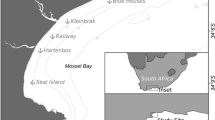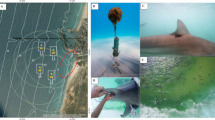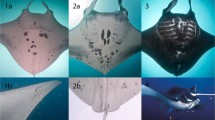Abstract
Groups or aggregations of animals can result from individuals being attracted to a common resource or because of synchronised patterns of daily or seasonal activity. Although mostly solitary throughout its distribution, white sharks (Carcharodon carcharias) seasonally aggregate at a number of sites worldwide to feed on calorie-rich pinnipeds. At the Neptune Islands, South Australia, large numbers of white sharks can be sighted throughout the year, including during periods of low seal abundance. We use a combination of photo-identification and network analysis based on co-occurrence of individuals visiting the site on the same day to elucidate the population structure and aggregatory behaviour of Australia’s largest aggregation of sub-adult and adult white sharks. We photo-identified 282 sharks (183 males, 97 females, 2 unknown) over a 4.5-year period (June 2010–November 2014) and found that white sharks did not randomly co-occur with their conspecifics, but formed four distinct communities. Tendency to co-occur varied across months with males co-occurring with more individuals than females. Sex-dependent patterns of visitation at the Neptune Islands and resulting intraspecific competition likely drive the observed community structure and temporal variability in co-occurrences. This study provides new insights into the aggregatory behaviour of white sharks at a seal colony and shows for the first time that white shark co-occurrence can be non-random.
Significance statement
White sharks are top marine predators that are typically solitary but can also form aggregations around seal colonies to feed. Using a combination of photo-identification and network analysis, we investigated the co-occurrence patterns of white sharks. We showed, for the first time, that white sharks form non-random associations with conspecifics. We hypothesise that the observed sex-dependant variations in co-occurrence are linked to intraspecific competition for resources, providing new insights into the aggregatory behaviour of white sharks at a seal colony. Our study adds to the growing literature of animals showing non-random interaction or co-occurrence patterns, providing important comparative knowledge for other researchers as it broadens our knowledge to marine top predators.



Similar content being viewed by others
Data availability
The datasets generated and analysed during the current study are available from the corresponding author on reasonable request.
References
Anderson SD, Chapple TK, Jorgensen SJ, Klimley AP, Block BA (2011) Long-term individual identification and site fidelity of white sharks, Carcharodon carcharias, off California using dorsal fins. Mar Biol 158:1233–1237
Aplin LM, Farine DR, Morand-Ferron J, Cockburn A, Thornton A, Sheldon BC (2015) Experimentally induced innovations lead to persistent culture via conformity in wild birds. Nature 518:538–541
Armansin N, Lee K, Huveneers C, Harcourt R (2016) Integrating social network analysis and fine-scale positioning to characterize the associations of a benthic shark. Anim Behav 115:245–258
Atton N, Galef B, Hoppitt W, Webster M, Laland K (2014) Familiarity affects social network structure and discovery of prey patch locations in foraging stickleback shoals. Proc R Soc B 281:20140579
Baylis AM, Page B, Peters K, McIntosh R, McKenzie J, Goldsworthy S (2005) The ontogeny of diving behaviour in New Zealand fur seal pups (Arctocephalus forsteri). Can J Zool 83:1149–1161
Bejder L, Fletcher D, Bräger S (1998) A method for testing association patterns of social animals. Anim Behav 56:719–725
Bezanson M, Garber PA, Murphy JT, Premo LS (2008) Patterns of subgrouping and spatial affiliation in a community of mantled howling monkeys (Alouatta palliata). Am J Primatol 70:282–293
Brena PF, Mourier J, Planes S, Clua EE (2018) Concede or clash? Solitary sharks competing for food assess rivals to decide. Proc R Soc B 285:20180006
Bruce BD, Bradford RW (2013) The effects of shark cage-diving operations on the behaviour and movements of white sharks, Carcharodon carcharias, at the Neptune Islands, South Australia. Mar Biol 160:889–907
Bruce B, Bradford R (2015) Segregation or aggregation? Sex-specific patterns in the seasonal occurrence of white sharks Carcharodon carcharias at the Neptune Islands, South Australia. J Fish Biol 87:1355–1370
Cairns SJ, Schwager SJ (1987) A comparison of association indices. Anim Behav 35:1454–1469
Compagno LJV (2001) Sharks of the world. An annotated and illustrated catalogue of shark species known to date, vol. 2. Bullhead, mackerel and carpet sharks (Heterodontiformes, Lamniformes and Orectolobiformes). FAO, Rome, Italy
Couzin ID, Krause J, Franks NR, Levin SA (2005) Effective leadership and decision-making in animal groups on the move. Nature 433:513–516
Croft D, Arrowsmith B, Webster M, Krause J (2004) Intra-sexual preferences for familiar fish in male guppies. J Fish Biol 64:279–283
Croft DP, James R, Krause J (2008) Exploring animal social networks. Princeton University Press, Princeton
Croft DP, Madden JR, Franks DW, James R (2011) Hypothesis testing in animal social networks. Trends Ecol Evol 26:502–507
Cross PC, Lloyd-Smith JO, Bowers JA, Hay CT, Hofmeyr M, Getz WM (2004) Integrating association data and disease dynamics in a social ungulate: bovine tuberculosis in African buffalo in the Kruger National Park. Ann Zool Fenn 41:879–892
Csárdi G, Nepusz T (2006) The igraph software package for complex network. Int J Complex Syst 1695:1–9
Domeier ML (2012) Global perspectives on the biology and life history of the white shark. CRC Press, Boca Raton
Domeier M, Nasby-Lucas N (2007) Annual re-sightings of photographically identitifed white sharks (Carcharodon carcharias) at an eastern Pacific aggregation site (Guadalupe Island, Mexico). Mar Biol 150:977–984
Duffy C, Francis MP, Manning MJ, Bonfil R (2012) Regional population connectivity, oceanic habitat, and return migration revealed by satellite tagging of white sharks, Carcharodon carcharias, at New Zealand aggregation sites. In: Domeier ML (ed) Global perspectives on the biology and life history of the white shark. CRC Press, Boca Raton
Farine DR (2013) Animal social network inference and permutations for ecologists in R using asnipe. Methods Ecol Evol 4:1187–1194
Farine DR (2014) Measuring phenotypic assortment in animal social networks: weighted associations are more robust than binary edges. Anim Behav 89:141–153
Farine DR (2017) A guide to null models for animal social network analysis. Methods Ecol Evol 8:1309–1320
Farine DR, Whitehead H (2015) Constructing, conducting and interpreting animal social network analysis. J Anim Ecol 84:1144–1163
Fewell JH (2003) Social insect networks. Science 301:1867–1870
Findlay R, Gennari E, Cantor M, Tittensor D (2016) How solitary are white sharks: social interactions or just spatial proximity? Behav Ecol Sociobiol 70:1735–1744
Finger J, Dhellemmes F, Guttridge T (2017) Personality in elasmobranchs with a focus on sharks: early evidence, challenges, and future directions. In: Vonk J, Weiss A, Kuczaj SA (eds) Personality in nonhuman animals. Springer, Berlin, pp 129–152
Franks DW, Ruxton GD, James R (2010) Sampling animal association networks with the gambit of the group. Behav Ecol Sociobiol 64:493–503
Godfrey SS, Bull CM, James R, Murray K (2009) Network structure and parasite transmission in a group living lizard, the gidgee skink, Egernia stokesii. Behav Ecol Sociobiol 63:1045–1056
Goldman KJ, Anderson SD (1999) Space utilization and swimming depth of white sharks, Carcharodon carcharias, at the South Farallon Islands, central California. Environ Biol Fish 56:351–364
Goldsworthy SD (2006) Maternal strategies of the New Zealand fur seal: evidence for interannual variability in provisioning and pup growth strategies. Aust J Zool 54:31–44
Gubili C, Johnson R, Gennari E, Oosthuizen WH, Kotze D, Meyer M, Sims DW, Jones CS, Noble LR (2009) Concordance of genetic and fin photo-identification in the great white shark, Carcharodon carcharias, off Mossel Bay, South Africa. Mar Biol 156:2199–2207
Guttal V, Couzin ID (2010) Social interactions, information use, and the evolution of collective migration. Proc Natl Acad Sci U S A 107:16172–16177
Guttridge TL, Gruber SH, Krause J, Sims DW (2010) Novel acoustic technology for studying free-ranging shark social behaviour by recording individuals’ interactions. PLoS One 5:e9324
Guttridge TL, Gruber SH, DiBattista JD, Feldheim KA, Croft DP, Krause S, Krause J (2011) Assortative interactions and leadership in a free-ranging population of juvenile lemon shark Negaprion brevirostris. Mar Ecol Prog Ser 423:235–245
Hay D, McKinnell S (2002) Tagging along: association among individual Pacific herring (Clupea pallasi) revealed by tagging. Can J Fish Aquat Sci 59:1960–1968
Hewitt AM, Kock AA, Booth AJ, Griffiths CL (2018) Trends in sightings and population structure of white sharks, Carcharodon carcharias, at Seal Island, False Bay, South Africa, and the emigration of subadult female sharks approaching maturity. Environ Biol Fish 101:39–54
Höjesjö J, Johnsson JI, Petersson E, Järvi T (1998) The importance of being familiar: individual recognition and social behavior in sea trout (Salmo trutta). Behav Ecol 9:445–451
Huveneers C, Lloyd M (2017) Residency of white sharks, Carcharodon carcharias, at the Neptune Islands Group Marine Park (2016–17). Flinders University, Adelaide
Huveneers C, Rogers PJ, Beckmann C, Semmens J, Bruce B, Seuront L (2013) The effects of cage-diving activities on the fine-scale swimming behaviour and space use of white sharks. Mar Biol 160:2863–2875
Huveneers C, Holman D, Robbins R, Fox A, Endler JA, Taylor AH (2015) White sharks exploit the sun during predatory approaches. Am Nat 185:562–570
Huveneers C, Meekan MG, Apps K, Ferreira LC, Pannell D, Vianna GM (2017) The economic value of shark-diving tourism in Australia. Rev Fish Biol Fish 27:665–680
Jacoby DM, Freeman R (2016) Emerging network-based tools in movement ecology. Trends Ecol Evol 31:301–314
Jacoby DM, Brooks EJ, Croft DP, Sims DW (2012) Developing a deeper understanding of animal movements and spatial dynamics through novel application of network analyses. Methods Ecol Evol 3:574–583
Jacoby DM, Fear LN, Sims DW, Croft DP (2014) Shark personalities? Repeatability of social network traits in a widely distributed predatory fish. Behav Ecol Sociobiol 68:1995–2003
Jacoby DM, Papastamatiou YP, Freeman R (2016) Inferring animal social networks and leadership: applications for passive monitoring arrays. J R Soc Interface 13:20160676
Johnson DD, Kays R, Blackwell PG, Macdonald DW (2002) Does the resource dispersion hypothesis explain group living? Trends Ecol Evol 17:563–570
Keller BA, Finger J-S, Gruber SH, Abel DC, Guttridge TL (2017) The effects of familiarity on the social interactions of juvenile lemon sharks, Negaprion brevirostris. J Exp Mar Biol Ecol 489:24–31
Klimley AP, Ainley DG (1996) Great white sharks: the biology of Carcharodon carcharias. Academic Press, London
Klimley A, Le Boeuf B, Cantara K, Richert J, Davis S, Van Sommerman S (2001) Radio acoustic positioning as a tool for studying site-specific behavior of the white shark and other large marine species. Mar Biol 138:429–446
Kock A, O’Riain MJ, Mauff KM, Kotze D, Griffiths C (2013) Residency, habitat use and sexual segregation of white sharks, Carcharodon carcharias in False Bay, South Africa. PLoS One 8:e55048
Komdeur J (1992) Importance of habitat saturation and territory quality for evolution of cooperative breeding in the Seychelles warbler. Nature 358:493–495
Krause J, Ruxton GD (2002) Living in groups. Oxford University Press, Oxford
Krause J, Croft D, James R (2007) Social network theory in the behavioural sciences: potential applications. Behav Ecol Sociobiol 62:15–27
Laroche KR, Kock AA, Dill LM, Oosthuizen H (2007) Effects of provisioning ecotourism activity on the behaviour of white sharks Carcharodon carcharias. Mar Ecol Prog Ser 338:199–209
Lavoie D, Simard Y, Saucier FJ (2000) Aggregation and dispersion of krill at channel heads and shelf edges: the dynamics in the Saguenay-St. Lawrence Marine Park. Can J Fish Aquat Sci 57:1853–1869
Leu ST, Godfrey SS (2018) Advances from the nexus of animal behaviour and pathogen transmission: new directions and opportunities using contact networks. Behaviour 155:567–583
Leu ST, Farine DR, Wey TW, Sih A, Bull CM (2016) Environment modulates population social structure: experimental evidence from replicated social networks of wild lizards. Anim Behav 111:23–31
Lusseau D, Wilson B, Hammond PS, Grellier K, Durban JW, Parsons KM, Barton TR, Thompson PM (2006) Quantifying the influence of sociality on population structure in bottlenose dolphins. J Anim Ecol 75:14–24
Mackas DL, Louttit GC (1988) Aggregation of the copepod Neocalanus plumchrus at the margin of the Fraser River plume in the Strait of Georgia. Bull Mar Sci 43:810–824
Marshall AD, Pierce SJ (2012) The use and abuse of photographic identification in sharks and rays. J Fish Biol 80:1361–1379
Marshall AD, Dudgeon CL, Bennett M (2011) Size and structure of a photographically identified population of manta rays Manta alfredi in southern Mozambique. Mar Biol 158:1111–1124
Martin RA (2007) A review of shark agonistic displays: comparison of display features and implications for shark-human interactions. Mar Freshw Behav Physiol 40:3–34
Martin RA, Hammerschlag N, Collier RS, Fallows C (2005) Predatory behaviour of white sharks (Carcharodon carcharias) at Seal Island, South Africa. J Mar Biol Assoc UK 85:1121–1135
Milinski M (1987) Tit for tat in sticklebacks and the evolution of cooperation. Nature 325:433–435
Möller LM, Beheregaray L, Allen SJ, Harcourt R (2006) Association patterns and kinship in female indo-Pacific bottlenose dolphins (Tursiops aduncus) of southeastern Australia. Behav Ecol Sociobiol 61:109–117
Mourier J, Vercelloni J, Planes S (2012) Evidence of social communities in a spatially structured network of a free-ranging shark species. Anim Behav 83:389–401
Nasby-Lucas N, Domeier ML (2012) Use of photo identification to describe a white shark aggregation at Guadalupe Island, Mexico. In: Domeier ML (ed) Global perspectives on the biology and life history of the white shark. CRC Press, Boca Raton, pp 381–392
Nazimi L, Robbins WD, Schilds A, Huveneers C (2018) Comparison of industry-based data to monitor white shark cage-dive tourism. Tour Manag 66:263–273
Newman ME (2004) Analysis of weighted networks. Phys Rev E70:056131
Newman ME (2006) Modularity and community structure in networks. Proc Natl Acad Sci U S A 103:8577–8582
Papastamatiou YP, Bodey T, Friedlander A, Lowe C, Bradley D, Weng K, Priestley V, Caselle J (2018) Spatial separation without territoriality in shark communities. Oikos 127:767–779
R Core Team (2017) R: a language and environment for statistical computing. R Foundation for Statistical Computing, Vienna, Austria, http://www.R-project.org
Robbins RL (2007) Environmental variables affecting the sexual segregation of great white sharks Carcharodon carcharias at the Neptune Islands South Australia. J Fish Biol 70:1350–1364
Robbins R, Fox A (2013) Further evidence of pigmentation change in white sharks, Carcharodon carcharias. Mar Freshw Res 63:1215–1217
Rogers P, Huveneers C (2016) Residency and photographic identification of white sharks Carcharodon carcharias in the Neptune Islands Group Marine Park between 2013 and 2015. SARDI publication no. F2015/000825-1. SARDI research report series no. 893. South Australian Research and Development Institute (aquatic sciences), Adelaide, South Australia
Ryklief R, Pistorius P, Johnson R (2014) Spatial and seasonal patterns in sighting rate and life-history composition of the white shark Carcharodon carcharias at Mossel Bay, South Africa. Afr J Mar Sci 36:449–453
Sah P, Leu ST, Cross PC, Hudson PJ, Bansal S (2017) Unraveling the disease consequences and mechanisms of modular structure in animal social networks. Proc Natl Acad Sci U S A 201613616
Semmens J, Payne N, Huveneers C, Sims DW, Bruce B (2013) Feeding requirements of white sharks may be higher than originally thought. Sci Rep 3:1471
Sperone E, Micarelli P, Andreotti S, Spinetti S, Andreani A, Serena F, Brunelli E, Tripepi S (2010) Social interactions among bait-attracted white sharks at Dyer Island (South Africa). Mar Biol Res 6:408–414
Skomal, GB, Chisholm J, Correia SJ (2012) Implications of increasing pinniped populations on the diet and abundance of white sharks off the coast of Massachusetts. In: DomeierML (ed) Global perspectives on the biology and life history of the white shark. CRC Press, Boca Raton, pp 405–418
Sperone E, Micarelli P, Andreotti S, Brandmayr P, Bernabò I, Brunelli E, Tripepi S (2012) Surface behaviour of bait-attracted white sharks at Dyer Island (South Africa). Mar Biol Res 8:982–991
Towner AV, Wcisel MA, Reisinger RR, Edwards D, Jewell OJ (2013) Gauging the threat: the first population estimate for white sharks in South Africa using photo identification and automated software. PLoS One 8:e66035
Weng KC, Boustany AM, Pyle P, Anderson SD, Brown A, Block BA (2007) Migration and habitat of white sharks (Carcharodon carcharias) in the eastern Pacific Ocean. Mar Biol 152:877–894
Whitehead H (2008) Analyzing animal societies: quantitative methods for vertebrate social analysis. University of Chicago Press, Chicago
Wilson AD, Brownscombe JW, Krause J, Krause S, Gutowsky LF, Brooks EJ, Cooke SJ (2015) Integrating network analysis, sensor tags, and observation to understand shark ecology and behavior. Behav Ecol 26:1577–1586
Acknowledgements
We thank Rachel Robbins who initiated the use of photo-identification at the Neptune Islands to assess the white shark population dynamics. We also thank Tullio Rossi from Animate Your Science (https://www.animateyour.science/) for designing the white shark photo-identification catalogue. A large number of volunteers are thanked for their assistance with photo and video sorting and processing. We thank the anonymous reviewers who helped improving this manuscript.
Funding
The Norman Wettenhall Foundation contributed funds towards a white shark photo-identification catalogue.
Author information
Authors and Affiliations
Corresponding author
Ethics declarations
Ethical approval
AF owns a cage-diving licence and business at the study sites which enabled the photographs to be collected. The study conformed with the Australian code for the care and use of animals for scientific purposes.
Conflict of interest
The authors declare that they have no conflict of interest.
Additional information
Communicated by S. D. Twiss
Publisher’s note
Springer Nature remains neutral with regard to jurisdictional claims in published maps and institutional affiliations.
Electronic supplementary material
ESM 1
(DOCX 25 kb)
Rights and permissions
About this article
Cite this article
Schilds, A., Mourier, J., Huveneers, C. et al. Evidence for non-random co-occurrences in a white shark aggregation. Behav Ecol Sociobiol 73, 138 (2019). https://doi.org/10.1007/s00265-019-2745-1
Received:
Revised:
Accepted:
Published:
DOI: https://doi.org/10.1007/s00265-019-2745-1




